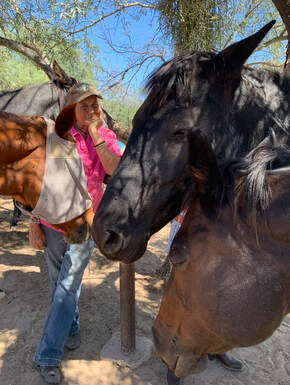HOW HORSES HELP HUMANS COMMUNICATE
Working or living closely with animals, it may get to a point when communicating with them feels like second nature. How many of us have dogs or cats at home we regularly speak to? With horses, it is often a combination of vocal cues and body language that tells us how they are feeling and thinking, what they would like to do, or what they would like us to do on their behalf. In the process of communicating with them, there are lessons that we often unknowingly pick up as we are more focused on the interaction itself. By taking the time to reflect on what it takes to connect with horses, we discover all the ways they teach us to become better communicators.
Develop patience
There's a lot of waiting, trial and error, and repetition when trying to get our message across to horses, and vice versa. Horses also try to convey their messages to us and we may misinterpret them. While it can be frustrating from time to time for both humans and animals, it’s important to acknowledge the effort and patience that both parties exert. Patience is what helps us to keep going until we are able to determine the best way to understand one another.
Pay close attention
Horses respond to our tone of voice, facial expressions, and other non-verbal cues. They pay close attention to us. And if we pay close attention to them and how they respond to us, we can get a step closer to recognizing the meaning behind their sounds and behaviors. Being aware of how we engage with horses, we can learn more about ourselves and our own style of communication.
Self-awareness and awareness of our surroundings
Besides the cues that we receive from horses, we also tune in to what is happening in the environment and in the present moment. Is the weather too hot for them? Too cold? Is it too crowded? Too noisy? Is there a scent that they are reacting to? Is there something that is alerting or scaring them away? We can also look internally at ourselves. Horses are known to mirror behavior and actions. If we are exhibiting frustration or anger, we may be sending a signal to them to stop interacting with us.
Exercise empathy
Without words to tell us explicitly how they feel, one of the kindest ways we can try to understand horses is through empathy. By putting ourselves in their position, we can bring ourselves closer to understanding what they are feeling or what causes them to behave a certain way.
Trust and respect
A crucial part of connecting with horses is trust, as trust communicates safety. Interestingly, horses have the ability to determine if it is safe to trust. A study conducted at the University of Tokyo found that horses can determine congruence in humans - specifically if facial expressions and body language match the tone of voice. For a horse, it is not safe to trust incongruence as it could mean potential harm or danger. If a horse distances itself or indicates that it does not want to engage, we respect its boundaries.
Set an intention
To demonstrate trust and openness to a horse, it helps to set an intention before an interaction. For example, in Mindful Grooming, participants attend the class with the intention of connecting and relaxing with the horses. As a result, both horses and humans feel a sense of ease and calm. Setting an intention helps align our behavior with our intended message, and as a result, it is easier for horses to understand us.
Horses teach us that communication barriers can be overcome - through patience, respect, empathy, and awareness of ourselves and what others might be experiencing. Taking these lessons with us as we engage with humans (or even other animals) can transform our conversations and make them more meaningful. When we communicate mindfully as we do with horses, we can create stronger connections with one another.
______________
Just like connecting with horses, connecting with people and the world at large requires not just words - it requires all five senses. Learn how to explore the world with all five of your senses in our upcoming EqU class, “In-Sight.” Discover different techniques that will help you focus, calm down, and experience the everyday world in a whole new way. Click here for more information and to register



